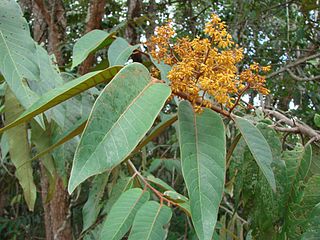
Virola is a genus of medium-sized trees native to the South American rainforest and closely related to other Myristicaceae, such as nutmeg. Species are known commonly as epená, patricá, or cumala. They have glossy, dark green leaves and clusters of tiny yellow flowers, and may emit a pungent odor.

The Myristicaceae are a family of flowering plants native to Africa, Asia, Pacific islands, and the Americas and has been recognized by most taxonomists. It is sometimes called the "nutmeg family", after its most famous member, Myristica fragrans, the source of the spices nutmeg and mace. The best known genera are Myristica in Asia and Virola in the Neotropics.

Tingo Maria National Park is located in the districts of Rupa Rupa and Mariano Dámaso, in the region of Huánuco, Peru. It was established on May 14, 1965 and its main attractions are the montane forest vegetation and the cave named Cueva de las Lechuzas where the oilbirds nest. The park has an area of 4,777 hectares (18.44 sq mi) that include a mountain massif called La Bella Durmiente.

Otto Warburg, was a German-Jewish botanist. He was also a notable industrial agriculture expert, and president of the Zionist Organization from 1911 to 1921.
Virola parvifolia is a species of plant in the family Myristicaceae. It is endemic to Brazil, Colombia and Venezuela.

Virola surinamensis, known commonly as baboonwood, ucuuba, ucuhuba and chalviande, is a species of flowering plant in the family Myristicaceae. It is found in Brazil, Costa Rica, Ecuador, French Guiana, Guyana, Panama, Peru, Suriname, and Venezuela. It has also been naturalized in the Caribbean. Its natural habitats are subtropical or tropical moist lowland forests, subtropical or tropical swamps, and heavily degraded former forest. Although the species is listed as threatened due to habitat loss by the IUCN, it is a common tree species found throughout Central and South America.

Virola sebifera is a species of tree in the family Myristicaceae, from North and South America.

Virola elongata is a species of tree in the family Myristicaceae. The tree is native to Panama, Guyana, Brazil, Bolivia, Colombia, Ecuador and Peru. It is also found in Suriname. Virola elongata is thin and 7.5–23 m (25–75 ft) tall, sometimes 30 m (98 ft) tall.
Virola calophylla is a species of tree in the family Myristicaceae. It is native to Central America and South America, namely Panama, Guyana, Suriname, Brazil, Bolivia, Colombia, Ecuador and Peru.

Virola carinata is a New World, tropical evergreen tree in the family Myristicaceae that is indigenous to Colombia, Venezuela and Brazil. It grows to a height of about 30m and its fruit is subglobular, 16–20 mm long and 17–19 mm in diameter, found in groups of 4 to 12.
Virola divergens is a species of tree in the family Myristicaceae. It grows to about 25m tall. The fruits are ellipsoidal and subglobular, 18–38 mm long and 16–33 mm in diameter, grouped 4 to 8.
Virola pavonis is a species of tree in the family Myristicaceae. It is found in Brazil, Colombia, Ecuador, Peru and Venezuela. The tree grows to a height of about 15-30m tall.
Virola peruviana is a species of tree in the family Myristicaceae. It is found in Brazil, Colombia, Ecuador and Peru. It grows to a height of about 35 m (100 ft). The fruit is ellipsoidal, 14–24 mm long and 11–23 mm in diameter, forming groups of about 5 to 15.
Virola venosa is a species of tree in the family Myristicaceae. It is found in Colombia, Venezuela and Brazil. It grows 5–30 m (16–98 ft) tall.
Ucuhuba seed oil is the oil extracted from the seed of Virola surinamensis (ucuhuba). The ucuhuba tree is found in Brazil, Costa Rica, Ecuador, French Guiana, Guyana, Panama, Peru, Suriname, and Venezuela. Its seeds provide oil rich in myristic acid. The ucuhuba oil contains 13% lauric acid, 69% myristic acid, 7% palmitic acid and traces of oleic acid and linoleic acid. Myristic and lauric acids comprised 91.3 mole % of the total fatty acids. Although additional saturated fatty acids were found, they occurred only as minor components. Small amounts of several unsaturated fatty acids were found including 2.4% oleic acid and 0.4% linoleic acid.

Eusiderin is a neolignan found in Virola sp and Aniba sp.

The Verde para Sempre Extractive Reserve is an extractive reserve in the state of Pará, Brazil. The reserve supports sustainable use of Amazon rainforest resources by the local population. Both before and after creation of the reserve there have been violent conflicts between different groups seeking access to the resources.
DZSB, broadcasting as 104.1 Spirit FM, is a radio station owned and operated by the Roman Catholic Apostolic Vicariate of Calapan. The station's studio and transmitter are located along Durian St. near St. Benedict Chaplaincy, Brgy. Lalud, Calapan.

The COVID-19 pandemic in Mimaropa is part of the worldwide pandemic of coronavirus disease 2019 caused by severe acute respiratory syndrome coronavirus 2. The virus reached Mimaropa on March 20, 2020, when the first case of the disease was confirmed in Puerto Princesa.










